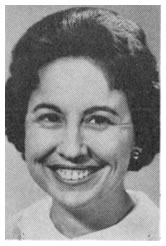
A vital member of the WBT-FM team was Matilda Massingill, the department secretary. Others were Don LeBrecht, manager, and Walker Gregory, sales rep.


A vital member of the WBT-FM team was Matilda Massingill, the department secretary. Others were Don LeBrecht, manager, and Walker Gregory, sales rep.
 |
In early 1966, when we’d settled WBT-FM in its new quarters, with its own studio in the recently-added wing of the building, we were programming live from Julian Price Place for a few hours a day, but the bulk of our programs, mostly unannounced popular music and a few weekly specialty shows (Bill Curry, jazz; Doug Mayes, country), emanated from the transmitter site on Spencer Mountain.
We had a staff of four: a manager, secretary, salesman and I, the production specialist, who acted as program manager, copywriter, sometime announcer, and did most producing, directing and recording.
It soon became obvious that relying on the transmitter engineers was not the best of schemes. It conflicted with their other duties (maintaining the WBTV and WBT-FM transmitters). The alternative, to run everything live from our studio site, was not a viable solution either.We began investigating several automation systems whose ads had begun to appear in broadcasting journals. The most promising, we thought, was one offered by Automatic Tape Control, of Bloomington, Illinois. Their system, they said, was...
...based on the theory that electronic circuits can operate broadcast equipment more efficiently than the human hand; and is economically feasible because the person who is relieved from switching duties can usually be employed more effectively with production, news, sales or other duties.
Yeah, man, right up our alley.
It was programmable, naturally, and configurable to suit any need. Mind you, there were no computers in those days. Digital was not a word we were much familiar with.
After considerable discussion with our studio engineers and upper management, we decided to go with the ATC system. We placed the order and ATC began assembling the components according to our specification.
Since I would be the one programming it, and engineering would have to reassemble, wire and maintain it, both Engineer Tommy Stutts and I departed for Bloomington one day in April to get checked out and accept delivery.
We had to change flights in Atlanta then spend the night in St. Louis. Not an auspicious beginning. Having had no supper I couldn’t resist the delicious looking hot dogs at St. Louis’ Lambert Field. Not at all like those bland ones back home. Probably bratwurst. Yum. I had two. My expense report, which I’ve kept, shows they cost $4.58, a reasonable price for three days of intense nausea.
 Came the dawn, our flight out of St. Louis was on Ozark Arlines, “the Route of the Swallows.” Our particular Swallow was a Douglas DC-3, a model first flown in 1935. When boarding, from toward the rear, you had to pull yourself up the aisle's steep incline by grabbing whatever was handy, not excluding the ears of seated passengers. I heard one mutter, “What the hell is this, Smoky Mountain Airways?” In the seat pocket I came across a note some long-ago passenger had left for Amelia Earhart, thinking she might be the pilot.
Came the dawn, our flight out of St. Louis was on Ozark Arlines, “the Route of the Swallows.” Our particular Swallow was a Douglas DC-3, a model first flown in 1935. When boarding, from toward the rear, you had to pull yourself up the aisle's steep incline by grabbing whatever was handy, not excluding the ears of seated passengers. I heard one mutter, “What the hell is this, Smoky Mountain Airways?” In the seat pocket I came across a note some long-ago passenger had left for Amelia Earhart, thinking she might be the pilot.
I became ill just as we were landing on a grassy strip in Mt. Vernon, Illinois, to let a passenger off. I got off as well, to vomit. And to my surprise, the pilot was also on the ground, rertrieving the lady’s suitcase from the baggage compartment. He graciously delayed our takeoff until I had finished.
Eventually we arrived in Bloomington, home of State Farm Insurance and the late Adlai Stevenson, and not far from Springfield where Abe Lincoln once practiced law. Through my bratwurst-induced nausea I first laid eyes on our very own ATC system. Tommy and I could only gape. Stretched out on the factory floor, it was sleek as a new Bonneville, and nearly as long.
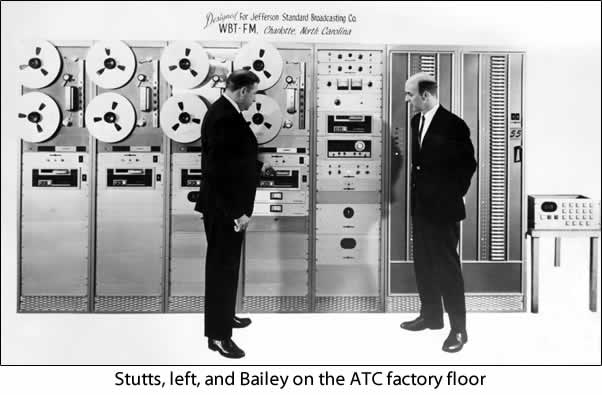 Fully loaded with tapes and carts, it was humming along as if showing off to company. As Tommy looked it over with a technical eye, I began bombarding ATC’s head honcho, Elmo Franklin, with programming questions. How do you switch to the network? What if there’s an unscheduled news bulletin? What if a cart jams? How does it produce a log? The questions continued ad nauseam, in every sense of the word.
Fully loaded with tapes and carts, it was humming along as if showing off to company. As Tommy looked it over with a technical eye, I began bombarding ATC’s head honcho, Elmo Franklin, with programming questions. How do you switch to the network? What if there’s an unscheduled news bulletin? What if a cart jams? How does it produce a log? The questions continued ad nauseam, in every sense of the word.
After a couple of days, satisfied with the system, we returned to Charlotte.
Two or three weeks later the shipment arrived. The room in which the system would reside was tiny, not deep enough to accommodate all seven equipment racks in a row as they had been aligned on the factory floor, so it had to be installed in an upside-down L configuration. And, because the racks were offset a couple of feet from the walls to allow access, the room could only comfortably hold about, oh, two people.
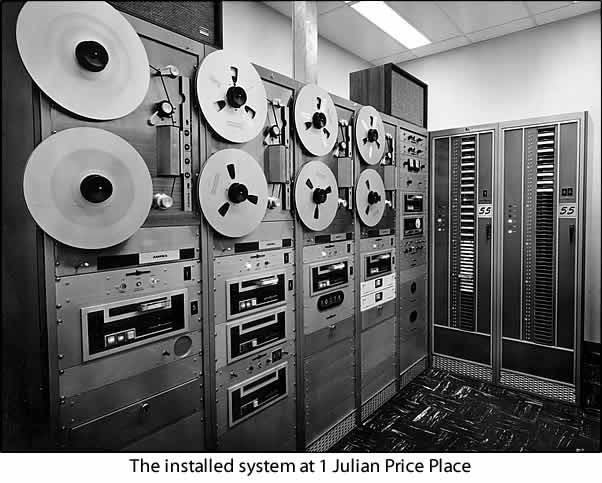 It was a system of individual Ampex tape decks and cart machines that were automated by pulses recorded on a special control cartridge. Each playback device, a “program source,” was physically and electronically numbered, and was called upon by that number to start.
It was a system of individual Ampex tape decks and cart machines that were automated by pulses recorded on a special control cartridge. Each playback device, a “program source,” was physically and electronically numbered, and was called upon by that number to start.
For announcements, there were six individual cart units and two machines that each held a stack of up to 55 carts. Each "55" unit had a single playback head assembly. It would pull in a cart, play it when instructed by the control cartridge, then, like an elevator, move down to the next cart, pull it in…and wait. A special control tone was recorded on each cart tape at the end of its message to trigger the next event.
On the reel-to-reel music tapes, in order to switch between reels, a tone had to be recorded after each song, or at the end of a program.
The single input device (we didn’t know then to call it that) was a rotary telephone dial. The output, of course, was the broadcast itself. But there was one more output element: the station log, or at least a validation of the log. This was a paper tape, like a supermarket receipt, created by a small adding machine-like printer. This verified that the events specified on the actual log had indeed played and at what time.
The idea was for this system to sit there unattended, playing recorded programs, music, commercials, station breaks and network news just as instructed. Creating those instructions was the hard part. Making sure it performed them was even harder.
I spent the next couple of months recording dozens of hour-long music tapes, and testing the system. For a typical afternoon of test programming, I would load three of the R-to-R machines with instrumental tapes and the fourth with a vocals-only tape. Then I’d instruct the system to alternate between them, carefully injecting a vocal only occasionally, and the commercials and station breaks as required. To start an event at a precise time, such as a station break, the event preceding it (hopefully an instrumental) could be faded out, by inserting a numbered fade-out event.
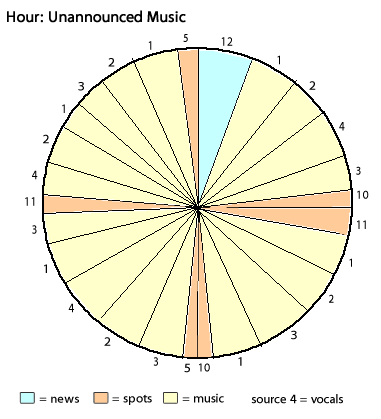 To plan a typical hour of unannounced music one drew a large circle on a piece of paper, in effect a pie chart, to represent a 60 minute clock, then drew slices to represent events, and applied a source number to each. To program this hour, you loaded a fresh cart in the control unit drive, and dialed in each event number, in sequence. You could actually dial in much longer time periods, even an entire day, but if you made a mistake, you’d have to start over at the beginning. You could easily make a mistake without knowing it. When finished dialing, you had to cycle through the cart to check the digits.
To plan a typical hour of unannounced music one drew a large circle on a piece of paper, in effect a pie chart, to represent a 60 minute clock, then drew slices to represent events, and applied a source number to each. To program this hour, you loaded a fresh cart in the control unit drive, and dialed in each event number, in sequence. You could actually dial in much longer time periods, even an entire day, but if you made a mistake, you’d have to start over at the beginning. You could easily make a mistake without knowing it. When finished dialing, you had to cycle through the cart to check the digits.
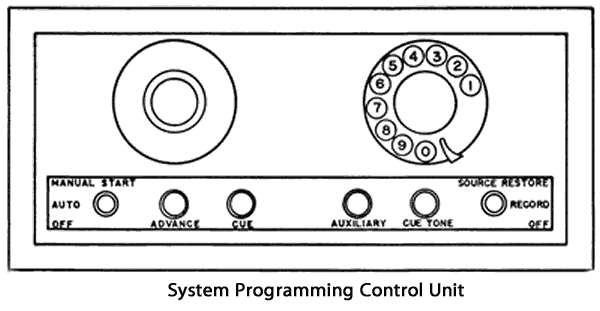 Finally, you loaded the tape decks precisely in the order dictated by the daily log and the clock diagram. At the appointed time, you pressed the Start button.
Finally, you loaded the tape decks precisely in the order dictated by the daily log and the clock diagram. At the appointed time, you pressed the Start button.
Ideally, you could then go do other things, or even go home. Realistically, wherever you were, you’d better monitor the station, because something was bound to go wrong. A cart might jam; a stop cue might fail. There were too many moving parts, too many opportunities for human error, and the basis for the entire operation was quarter-inch audio tape, not the most robust medium on which to pin your hopes.
Perhaps we were demanding too much of the system in trying to weave into the schedule live shows, packaged hours, network cut-ins, as well as the automated music rotation. What would be a snap in today’s digital world was something the linear technology of the ‘60s simply couldn't handle.
And we were understaffed. In retrospect, it might have been worth it to hire someone to be present during automated periods, creating new program material and keeping an ear out for system mishaps. Many times I called in from home—even from restaurants!—to get someone (a WBTV reporter, the security guard, any warm, breathing human) to run upstairs and punch a few buttons. Often I would have to return to the station to unravel the mess.
In those days there were few if any cars with FM radios. In order to monitor the station while driving around, I found a RadioShack FM tuner that I duct-taped under the dash. The intermittently awful reception provided a totally unique listening experience.
After a year of this madness, it occurred to me there might be a better way to make a living, in which one did not have to live on pins and needles, waiting for the inevitable “system is down” call from the transmitter engineer—or a listener! One day there came an opening in the WBTV Promotion Department. I leaped—and never looked back. Although my new office was located only 20 yards down the hall, I never noticed what happened in WBT-FM after that. It had worn me out. I detested the very thought of it.
Four years later, in 1972, when I took a job in Jefferson Productions—located in the very same offices that FM had occupied when I left—the entire FM operation, including the ATC system, had been moved someplace else in the building. I was too busy to ask where. Perhaps it was during this period when the station was redefined and renamed to WBCY.
I suspect the automation system was ultimately cannibalized for parts. Good riddance.
OMG, Reno, what a great article on FM's automated monster! You can't believe how intimidated I was with that machine when I began working there with you that short summer. But as you promised would happen, I figured it out pretty quickly, and it became the basis for my understanding of computers later in life. Is it possible that there are other photos of the monster and our FM studio equipment?
I recall having only one problem with it. After you, Don, and Matilda had left each day, I had to stick around until Clyde McLean came up to record a weather cart to load into the monster for later broadcast. I would occasionally sneak down to the TV control room to watch the director and audio guy doing the evening news until Clyde finished his broadcast, then I would scurry back to FM to wait for his arrival. One night, one of the AM engineers (I think it was Tommy Stutts) saw me there, poked his head in the TV control room door, and told me that the monster wasn't working, and he didn't know why. We both hustled down to FM where I quickly discovered that the control tape had wrapped itself around the control unit capstan. I operated the monster in the manual mode while we delicately removed the control tape from the unit. Once out, I cleaned the capstan, loaded the backup control tape, advanced it to the proper point for the time of day, and re-engaged the automatic system. When it began receiving instructions from the control unit again, everything ran fine.
I thought I had a second problem another night, but the problem was with my memory, not the machine. "Curry—And All That Jazz" was recorded on reel-to- reel and installed on the big Ampex deck in the FM studio that was one of the monster's sources, but usually wasn't connected to it. I'm sure you remember that we had to remove a dummy plug from the back of that Ampex deck and then plug it into the automated system. One Friday night, I was on a date with my girlfriend. About an hour before Curry's show began, I got this horrible feeling that I had loaded the tape, but had forgotten to make the connection in the back. She and I took off for the station where I discovered that everything was connected as it needed to be, and the program began right on time.
I also recall that we got our big reel to reel music tapes from a subscription service, and BT-FM was the only station that was allowed to edit their tapes by physically snipping out what songs you didn't like.
When my summer at BT-FM ended, Don Lebrecht recommended that I submit an application to WIST that was in the process of switching to automation. Since I had some experience with it, they hired me on the spot. Their system was very similar to ours, but it used carrousel cart decks instead of the in-line "55" decks that we had. Also, their control unit used a touch-tone telephone keypad instead of the rotary dialer, but the source codes were still saved to a tape cart. Unfortunately, we never could get their machine to work even an hour at a time. After I left the station a few months later to join the Army (it was "join or be drafted"), I learned that they had returned the unit to ATC, along with three others that their parent broadcast group had purchased that had the same unsatisfactory result.
Thanks again for including me on your BT Memories email list. I have thoroughly enjoyed reading everything you have there.